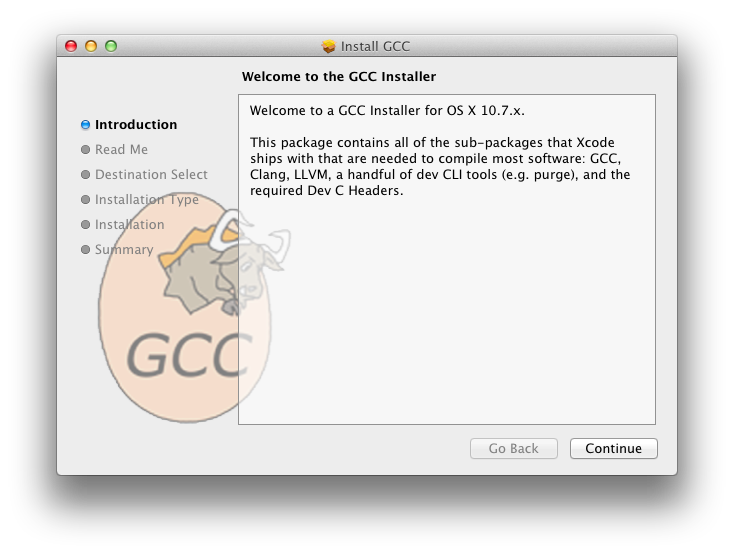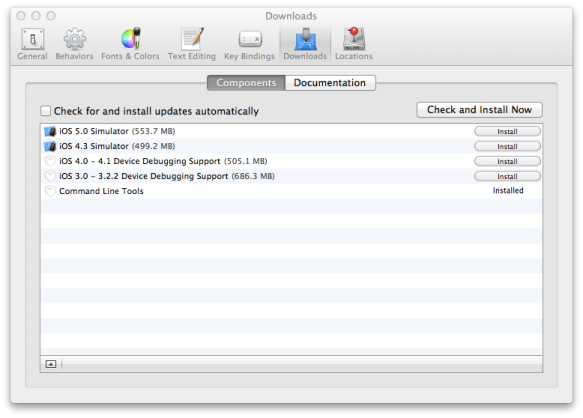Gcc Mac Os X
Other projects packaging GCC (and gfortran) binaries for Mac include: Homebrew offers the latest stable gfortran release as part of the 'gcc' package. HPC Mac OS X offers GCC builds, which include gfortran. MacPorts (package name, e.g., 'gcc48') - the fastest way to get a developer version of GCC. Doing it Right¶. Let’s install a real version of Python. Before installing Python, you’ll need to install GCC. GCC can be obtained by downloading Xcode, the smaller Command Line Tools (must have an Apple account) or the even smaller OSX-GCC-Installer package.
Mac OS X comes with Python 2.7 out of the box.
You do not need to install or configure anything else to use Python 2. Theseinstructions document the installation of Python 3.
The version of Python that ships with OS X is great for learning, but it’s notgood for development. The version shipped with OS X may be out of date from theofficial current Python release,which is considered the stable production version.
Doing it Right¶
Let’s install a real version of Python.
Before installing Python, you’ll need to install GCC. GCC can be obtainedby downloading Xcode, the smallerCommand Line Tools (must have anApple account) or the even smaller OSX-GCC-Installerpackage.
Note
If you already have Xcode installed, do not install OSX-GCC-Installer.In combination, the software can cause issues that are difficult todiagnose.
Note
If you perform a fresh install of Xcode, you will also need to add thecommandline tools by running xcode-select--install on the terminal.
Gcc Download Mac Os X
While OS X comes with a large number of Unix utilities, those familiar withLinux systems will notice one key component missing: a package manager.Homebrew fills this void.
To install Homebrew, open Terminal oryour favorite OS X terminal emulator and run
The script will explain what changes it will make and prompt you before theinstallation begins.Once you’ve installed Homebrew, insert the Homebrew directory at the topof your PATH environment variable. You can do this by adding the followingline at the bottom of your ~/.profile file
If you have OS X 10.12 (Sierra) or older use this line instead
Now, we can install Python 3:
This will take a minute or two.
Pip¶

Homebrew installs pip pointing to the Homebrew’d Python 3 for you.
Working with Python 3¶
At this point, you have the system Python 2.7 available, potentially theHomebrew version of Python 2 installed, and the Homebrewversion of Python 3 as well.
will launch the Homebrew-installed Python 3 interpreter.

will launch the Homebrew-installed Python 2 interpreter (if any).
will launch the Homebrew-installed Python 3 interpreter.

If the Homebrew version of Python 2 is installed then pip2 will point to Python 2.If the Homebrew version of Python 3 is installed then pip will point to Python 3.
The rest of the guide will assume that python references Python 3.
Pipenv & Virtual Environments¶
Gcc For Mac Os X 10.3
The next step is to install Pipenv, so you can install dependencies and manage virtual environments.
A Virtual Environment is a tool to keep the dependencies required by different projectsin separate places, by creating virtual Python environments for them. It solves the“Project X depends on version 1.x but, Project Y needs 4.x” dilemma, and keepsyour global site-packages directory clean and manageable.
For example, you can work on a project which requires Django 1.10 while alsomaintaining a project which requires Django 1.8.
So, onward! To the Pipenv & Virtual Environments docs!
This page is a remixed version of another guide,which is available under the same license.

This page gathers links to all unofficial gfortran binary packages people regularly build, based on the current development gfortran source code.
Avr Gcc Mac Os X
Windows
MacOS
GNU/Linux
Build GNU Fortran from source
Note: There do not exist any official FSF/GNU/GCC binary builds (only source packages). Most of the builds below come from gfortran maintainers but not all.
Windows
If in doubt, or if you don't know what Cygwin and MinGW are, the package for you is the MinGW ('native Windows') package!
MinGW for Win64: The Mingw-w64 project has regularly updated snapshots of compilers generating 64-bit Windows executables. They provides several compilers, which run on Windows (32-bit and 64-bit Windows), Cygwin, Linux, and Darwin/MacOS - and which generate binaries for 32bit or 64bit Windows. The file name pattern is <target>-<host>-<option-version>-<date>; thus, mingw-w64-bin_x86_64-mingw_20100527.zip is a compiler targeting 64bit Windows (mingw-w64) but also running ('host') on 64bit Windows (xx86-64-mingw); you might search for the file in Toolchains targetting Win64 (Personal Builds or Automatized Builds).
MinGW build ('native Windows' build)
Official MinGW builds (only releases), last seen was 6.3.0 (2017-05-30)
The MinGW for Win64 project has also binaries for 32bit Windows; e.g. mingw-w32-bin_i686-mingw_<date>.zip runs on and generates binaries for 32bit Windows (cf. above); you might search for the file in Toolchains targetting Win32 (Personal Builds or Automatized Builds).
TDM GCC: MinGW/MinGW-W64 Builds
MinGW 32/64bit builds by www.Equation.com (builds were announced at comp.lang.fortran; note - equation.com is not affiliated with any MinGW or GCC developer. Use at your own risk)
Cygwin: The Cygwin project offers up-to-date builds of GCC and gfortran
Octave: Octave 6.1 comes with gcc/gfortran-9.3.1. From the Windows start menu, open up Octave and you will find the bash shell. Stick it to your task bar so it's always to hand. Combined with Notepad++ (https://notepad-plus-plus.org/), you will be able to get on with fortran development using nothing but GPL tools. Alternatively, the 'system' command can be used to run gfortran from the Octave GUI together with the Octave editor.
macOS
The gfortran maintainers offer nice Apple-style installers for macOS: https://github.com/fxcoudert/gfortran-for-macOS/releasesDetailed instructions can be found here.
Other projects packaging GCC (and gfortran) binaries for Mac include:
Homebrew offers the latest stable gfortran release as part of the 'gcc' package.
HPC Mac OS X offers GCC builds, which include gfortran
MacPorts (package name, e.g., 'gcc48') - the fastest way to get a developer version of GCC. MacPorts comes with a packing software, but all software is compiled before installation. For the developer version, the 'Portfile' is updated approx. weekly.
Fink offers GCC packages (all released versions) - similar to MacPorts, but also offers binaries; it does not have the developer versions, just the releases.
GNU/Linux
Most Linux distributions offer gfortran packages, some have also builds for the experimental versions
Nightly builds are available at:
Gcc For Mac Os X
32-bit processors (i686)
Download from gfortran.com
Installation instructions
64-bit AMD-compatible processors (x86_64, AMD64,Intel64, em64t)
Download from gfortran.com (README, nightly builds, 4.3 to 4.9 snapshots)
gcc-4.8-infrastructure package (GCC 4.8 and later; for GCC 4.3 to 4.7 use gcc-infrastructure), which contains required libraries (GMP, MPFR, MPC, etc.) - simply unpack in the 'gcc-trunk' (or 'gcc-4.6' or ...) directory
To unpack .xz files: Use xzcat with tar. It is contained in pre-build xz package, if you don't have it.
Needs to be updated: Installation instructions
Homebrew Gcc Mac Os X
Building from Source
See also InstallingGCC and http://gcc.gnu.org/install/
Gcc Compiler Mac Os X
- Obtain the source code either via
subversion
git
Bazaar
unpacking a tarball
You should have the right versions of GMP, MPFR and MPC (and optionally for Graphite: CLOOG and ISL) installed, which you can download from ftp://gcc.gnu.org/pub/gcc/infrastructure/ (They can also be automatically build with GCC.)
Note: You can use ./contrib/download_prerequisites to download them.
Follow the instructions; in a nutshell, you will do
create a build directory, e.g. gcc-build underneath the source directory
go to the build directory and run configure from there; for instance: ../configure --prefix=$HOME/gcc-trunk --enable-languages=c,fortran
run make
run make install
Useful configure options: --enable-checking=release which disables some compile-time checks which slow down the compiler; --disable-bootstrap which speeds up the build but uses the system compiler and disables some consistency checks; --disable-build-poststage1-with-cxx (for 4.7 or higher) avoids building GCC with a C++ compiler, esp. useful if no C++ should be compiled; --disable-libstdcxx-pch speeds up the compilation a bit by not creating pre-compiled header files.
